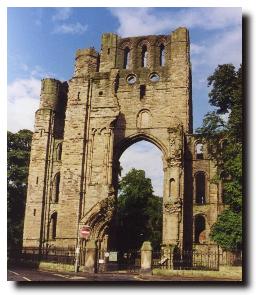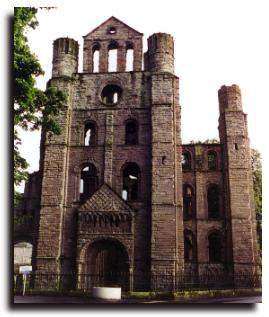 An abbey was founded by King Alexander I at Selkirk in 1113 but the Tironesian monks moved to Kelso when that abbey was established by King David I in 1128. The monks then started building the largest 13th century abbey in the Scottish Borders. The floor plan of the abbey in those days was in the shape of the cross of Lorraine - with two transepts or arms to the main building. The design was similar to that of abbeys on the river Rhine at that time, with solid looking turrets instead of a spire.
An abbey was founded by King Alexander I at Selkirk in 1113 but the Tironesian monks moved to Kelso when that abbey was established by King David I in 1128. The monks then started building the largest 13th century abbey in the Scottish Borders. The floor plan of the abbey in those days was in the shape of the cross of Lorraine - with two transepts or arms to the main building. The design was similar to that of abbeys on the river Rhine at that time, with solid looking turrets instead of a spire.
The abbey had considerable power and influence and its abbots at one stage claimed precedence over St Andrews Abbey. Later, King James III was crowned in Kelso Abbey in August 10, 1460, after the death of his father King James II at the siege of Roxburgh.
However, the story of the abbey thereafter is one of constant destruction by English invaders, many of whom passed through the area as the marched north into Scotland. In 1545 when the Earl of Hertford attacked the abbey, the defenders retreated into one of its towers but all 100 defenders and 12 monks were eventually massacred. By 1587 there were no monks left to look after the building. The ruins were used by the Covenanters (as a barracks) and part of the building was adapted as a local church.
 Today, the encroachment of the town of Kelso has resulted in the remaining building being almost as high as the area it covers. But the facade of the north transept is rated as the most spectacular piece of Romanesque architecture in Scotland. Sir Walter Scott described it as the most beautiful in Scotland.
Today, the encroachment of the town of Kelso has resulted in the remaining building being almost as high as the area it covers. But the facade of the north transept is rated as the most spectacular piece of Romanesque architecture in Scotland. Sir Walter Scott described it as the most beautiful in Scotland.
Perhaps the most striking feature of the abbey is its north-west transept (pictured here) with its fine doorway, with an ornamental arcade and a gable with diamond patterning above. Higher up, there are two levels of Norman windows, a round window above that and higher still, another gable between two towers. The tower was originally supported by four great arches and two of these remain.



